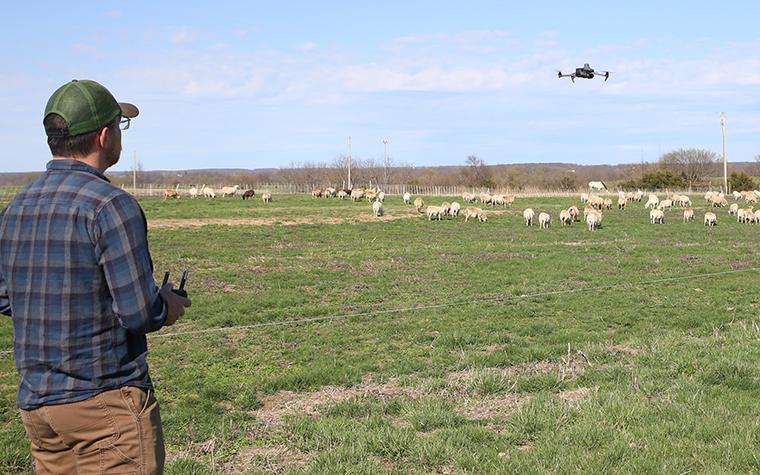The technology has moved from novelty to necessity on many farms and ranches.
COLUMBIA, Mo. – Enthusiasm for drone use in agriculture is growing quickly, says Caleb O’Neal, University of Missouri Extension field specialist in plant science.
O’Neal teaches classes about drones across the state. He’s seen interest from farmers, commercial sprayers, cow-calf operators, real estate professionals and some who are just curious about new technology. According to the American Spray Drone Coalition, acres sprayed in the United States increased from 4 million to 10.3 million from 2023 to 2024.
Drones much like the ATVs in the 1980s
O’Neal likens increased drone usage to what happened decades ago with all-terrain and utility task vehicles. “Back in the 1980s, it would have been rare to see a UTV being used on a farm,” he says. “Visiting farms today, I’m hard-pressed to find an operation larger than 20 acres that doesn’t have some type of UTV that they utilize on a regular basis.”
This likely will be the case of drones on the farm as more farmers and ranchers see what an incredible tool they are, he says. “Drones have progressed from being a neat toy we might get our kids for Christmas to becoming a necessity for many agricultural operations.”
Drones save time and money
Drones with high-resolution cameras can reduce the need for ground-based field inspections, O’Neal says. They can help row crop farmers identify nutrient deficiencies, locate areas of poor soil health, scout for insects and disease and make crop stand assessments.
Livestock producers can monitor fences and availability of water and can make sure animals are where they should be without even opening a gate. Drone technology lets cattlemen quickly check estrus indication patches for optimized breeding timing, monitor cows during calving season, look for hidden newborn calves and look out for potential predators.
“Time is one of a farmer’s most valuable and limited resources, so the more of it we can save while still completing the task, the better,” O’Neal says.
Drones in precision ag
But precision agriculture is where drones truly shine, he says. “Using data-driven insights, drones can enable farmers to apply site-specific fertilizers, pesticides and other inputs to maximize return on investment,” he says.
“A pasture with a rash of blackberry weeds in isolated areas has great potential for a prescription herbicide application where only the problematic areas receive treatment via a spray drone, as opposed to a broadcast application where the entirety of the field is treated whether it needs it or not. A targeted spray application like this minimizes waste, reduces negative environmental impact and often can leave more dollars in the wallet of the landowner due to reduced chemical costs.”
Drones provide accessibility
Drones also provide access to hard-to-reach areas of the farm, turning unproductive acreage into a moneymaker.
“In my neck of the woods in southwestern Missouri, the topography can be quite unforgiving, with some areas too harsh to allow access by ground spray rig or even ATV,” O’Neal says. “With an aerial piece of equipment like a utility drone, landowners can now get herbicide applications on these problematic areas and put them into useful forage production. With current land values reaching for the heavens, it can be difficult to justify buying more acreage as we try to expand our farming operations. It may be a more prudent investment to ensure every acre of land we already own is highly productive. If we can reclaim a quarter acre here and a half acre there on property we already own, it can add up quickly and make sense from an investment perspective.”
Training required
While drones are a wonderful asset in modern farming, there are inherent risks, as well as state and federal licensing requirements, says O’Neal.
Training programs hosted by MU Extension equip farmers and applicators with many tools for determining flight parameters different spray applications. Through research, MU Extension specialists have also found that there are times when conventional equipment such as a ground spray rig is a better option for an effective application.
“Drones are another tool available to modern farmers, and as most farmers will agree, you can never have too many tools,” says O’Neal. “As drone technology continues to advance, its potential uses in agriculture grow as well. On many farms, drones are saving producers time, reducing input costs and bringing new levels of productivity to their land. Drones are no longer futuristic machines; they are transforming agriculture today, and they are tools that can enable farmers to optimize every acre and ensure their operational success.”
Photo
Use of drones in agriculture is increasing as row crop and livestock producers find new ways to improve efficiency and productivity. Photo courtesy of Caleb O’Neal.
